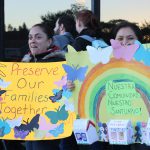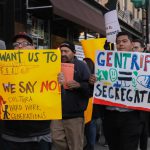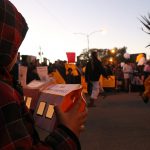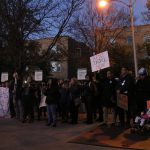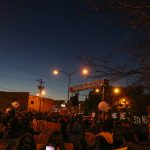By Alexis Shanes
Medill Reports
Ashley Galvan Ramos brought the most impassioned voice to a march by Logan Square residents against housing inequity, the latest in a string of riffs between activists and the city as rents skyrocket in their gentrifying neighborhood.
Galvan Ramos, the 20-year-old youth representative for the Logan Square Neighborhood Association, said she and her family found themselves displaced early this year after their landlord sold their apartment building without warning.
“It was really hard for us to move,” Galvan Ramos said. “We packed everything on the day of my sister’s quinceañera. We had nowhere to go.”
Her family spent a few days on the street before finding sanctuary in a family friend’s basement in the Belmont Cragin neighborhood.
“I gave up on school,” she said. “During the time I was supposed to be at school, I was walking around the neighborhood to look for an apartment.”
Her parents now are homeowners in Austin, approximately five miles southwest of Logan Square, thanks in part to support they received from the LSNA. But Galvan Ramos said she misses the community in which she lived for 13 years and hopes to return to Logan Square one day.
The neighborhood historically was recognized for its diversity, but nearly 20,000 Hispanic residents left the area between 2000 and 2014, according to U.S. Census data. Activists such as Galvan Ramos said gentrification is at the root of the problem.
Community members said the Chicago City Council members have not taken appropriate steps toward addressing the housing crisis in Logan Square, a responsibility that falls to the Chicago Department of Planning and Development. The city’s five-year housing plan, a document that guides the city’s housing policies and will expire in December.
A proposed draft of the new five-year Chicago housing plan, which would take effect in 2019, includes provisions for a new city Department of Housing. It would be “focused on supporting access to housing as a core component of all neighborhoods.”
A draft of Chicago Mayor Rahm Emanuel’s 2019 budget recommendations allocated more than $4.3 million for housing.
Alderman Carlos Ramirez-Rosa (D-29th), who will run for reelection Feb. 26, said the new housing plan should include provisions for new affordable housing in areas where gentrification is most problematic.
“The five-year housing plan really needs to be a plan that supports working Chicagoans, and that has substance and meat to it,” Ramirez-Rosa said. “That means dollars. That also means including undocumented immigrant families into that plan.”
State Rep. Will Guzzardi (D-39th) in February 2017 introduced a bill to repeal the 1997 Rent Control Preemption Act, which prevents local governments from establishing rules about rent — including making ordinances that prevent landlords from raising rent at their discretion.
However, some housing advocates argue that simply repealing the act is not enough. Lift the Ban Coalition, comprised mostly of housing advocacy groups, supports limiting annual changes in rental amounts to no more than the change in inflation and establishing rent control boards with elected representatives. The group estimates that in Logan Square, the difference between demanded and available affordable housing is 37 percent.
Ramirez-Rosa is among the local politicians who support legislation to repeal the act, which is on the Nov. 6 ballot in the 35th, 46th and 49th wards as an advisory referendum.
“We have seen multimillionaire developers purchase large apartment buildings, and from one month to the other, double the rent on the same exact apartment,” Ramirez-Rosa said. “That’s something that our working families can’t afford.”
Guzzardi added that gentrification is a “complex, multi-faceted challenge,” and he said he thinks residents are aware of a need for productive government intervention.
“The city has its hands tied by the state in terms of trying to solve this problem,” Guzzardi said. “We really believe that we need the government to intervene, keep the greed of landlords and developers from pushing people out of our community.”
The Chicago Housing Justice League, a group founded early in 2018, represents 37 groups and released a series of recommendations for the five-year housing plan that reflected the city’s priorities but added a category they call “democratizing decision-making,” designed to bring housing resolutions to the ward or aldermanic levels, said Michael Saelens, a spokesperson for the organization.
“If something doesn’t go into work, at least tell us why,” Saelens said. “That’s really all we really want. Chicago has a long history of being kind of opaque.
“[Chicago Mayor Rahm Emanuel’s] decision not to run for a third term has really thrown things into chaos,” he added.
One recommendation involves the city’s Affordable Requirements Ordinance, which currently requires developers to set aside at least 10 percent of the units as affordable and family-sized when the city approves rezoning of property.
But developers can pay a fee to provide comparable affordable units within two miles. As a result, most landlords choose to move the required affordable housing units off-site, contributing to displacement, Saelens said.
A new ARO proposal includes raising the provision requirement to 30 percent and eliminating the “carve-out” fee option.
“There’s push for it,” Saelens said. “There’s movement.”
However, the likelihood a new ARO rule will be approved is slim, Saelens said. He is unsure whether the City Council Committee on Housing and Real Estate will hold a hearing on the proposed option.
“I’m not holding my breath,” he said.
Norma Rios-Sierra, LSNA president, said the organization has proposed initiatives that would charge developers fees to provide funding for families to stay in their homes, along with a home ownership program for low-income families, more affordable housing units and a new mental health clinic.
“We are frustrated because we have presented viable solutions over the course of the year, and we have been ignored,” Rios-Sierra said. “It is troubling to see the rate at which my neighborhood is being sold out to developers.”
Unrest in the housing situation affects education as well, said Jhoanna Maldonado, a Chicago Public Schools special education teacher and the vice president of LSNA.
As Hispanic families leave, the school-age population has dipped, hurting both enrollment and educational resources, she said.
“We have to choose between music and art,” Maldonado said. “We no longer have a librarian. But the city has millions for developers.”
As tensions escalate, Guzzardi said he wanted protesters to know he supports their fight.
“They’re right to be angry and they’re right to be frustrated,” Guzzardi said, gesturing to the crowd nearby. “It’s time for us to come together and do something about it.”
After the march, when the protesters gathered in a parking lot, Galvan Ramos fought back tears as she retold her story to the marchers. But she said she hopes something good will grow out of her personal struggle.
“The feeling of being displaced still lingers,” she said. “That’s why I am proud to be here. I want all of you to look around and see each other right now. This is hope. This is community.”


